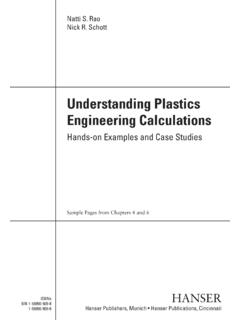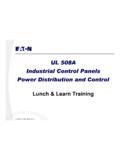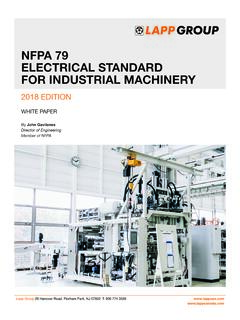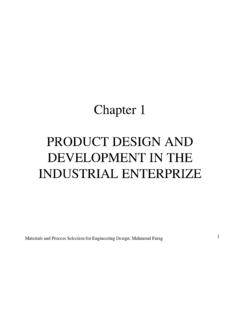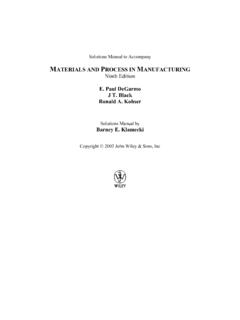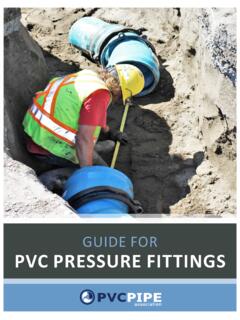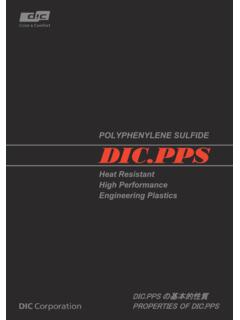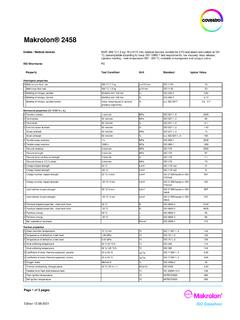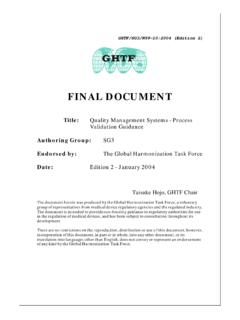Transcription of Plastic Part Design for Injection Molding
1 Plastic Part Designfor Injection MoldingAn Introduction2nd EditionRobert A. MalloyISBNs978-1-56990-436-71-56990-436- 7 HANSERH anser Publishers, Munich Hanser Publications, CincinnatiSample Chapter 5: Prototyping and Experimental Stress Analysis5 Prototyping and Experimental Prototyping Plastic PartsIt is generally best to develop both models and prototype parts during the plastics productdevelopment process. The prototyping stage of product development is crucial to the successof a project, yet this aspect of development is often hurried through or underfunded. Proto-type parts are used for communications, engineering studies, market studies/promotions, toevaluate product manufacturability/assembly characteristics, and to verify CAD model orprint accuracy.
2 Regardless of the medium chosen, prototyping techniques generate physicalmodels that act as a primary means of communication between Product Marketing, ProductEngineering, Tooling and Product Manufacturing groups. The use of a prototype to describethefunction,size,shape,feelandlo okofapartinevitablyleadstoamoreproductiv eenvi-ronment and a higher degree of interaction between the members of the product IntroductionPrototype parts have been characterized as being either (i) facsimile prototypes, which canserve both marketing and perhaps limited engineering functions, or (ii) processing proto-types, ( , those produced using prototype Injection molds or tools), which are used toevaluate both the Molding process and the molded part properties,before production toolingis fully committed [1, 2].
3 It is likely that at least one, or perhaps a series of facsimile proto-types ( , form and limitedfit/function prototype parts) would have been made before onecommits to the cost of preproduction or prototype latter step can add significanttime and initial cost to the process of product development. However, this step is necessarywhen working with new and unfamiliar materials, complex product geometries, structuralparts, or tighter tolerance applications, since thefunctionandfitof a molded Plastic prod-uct are strongly influenced by the tool Design and the manufacturing and Injection moldingconditions. Preproduction tool trial results allow the mold designer tofine tune the produc-tion mold Design , and provide the Design team with a potentially large number of nearly reallife prototype parts, which may be required for marketing or engineering studies.
4 It is impor-tant to note here that the use of computer aided process simulation software for injectionmolding has reduced the need for prototype tooling to a significant degree. Filling, cooling,shrinkage and warpage analysis packages are providing answers that were previously avail-able only through actual Molding trials [3]. A well designed simulation study will provideinformation on weld line locations and potential part weaknesses, possible gas traps, partwarpage or internal ( Molding ) stress levels as described in Chapter 2. The results obtainedusing this approach are of course simulated, and are often used in concert with prototype2865 Prototyping and Experimental Stress Analysistooling to optimize the Design of the process and product.
5 The simulation packages, at aminimum, reduce the need for major production tool shows the relative cost of a Design change with time. Design changes made earlyin the product Design cycle have minimal impact on overall cost. Design changes made latein the product development cycle can be extremely expensive and increase time to ($$$$$)Manufacturing($$$)Product engineering($$)Product Design ($)Relative cost of a Design changeTimeFigure cost of a Design change with timeThere are literally dozens of methods that can be used to produce prototype Plastic partsor assemblies. The method(s) that is best for a given application depends on the quantity ofprototype parts required, the size of the parts, the budget and time available, and perhapsmost importantly, on how true to life the prototype must be in terms of its engineeringfunctions.
6 Common Plastic prototype part production techniques include: Hand fabrication and machining of prototypes Photo polymerization prototyping Laser sintering Automatedfilament extrusion Laminated object manufacturing 3 Dprinting Polymer casting Molding prototypes using die cast tooling Molding prototypes using soft tooling Molding prototypes using pre-production tooling Structural foam prototypingVirtuallyanyprototypingtechni quecanbeusedtoproduceapartthatisesthetic allypleasing,however, only pre-production or prototype Molding techniques provide true to life infor-mation on product performance, moldability, and dimensional tolerances. The chemical,mechanical, electrical, thermal, and dimensional characteristics of molded Plastic parts areinfluenced by both the primary and secondary processing operations, indicating that prod-uct performance should ideally be evaluated using the production material formulation Prototyping Plastic Parts287the primary/secondary operations to be used in production.
7 At some point, the costs andtime associated with prototype development work of this type can exceed realistic levels,and one must generally rely on simulations or less realistic prototyping methods. The safetyfactors used in Design are directly influenced by the confidence the designer has in the proto-typing and experimental test methods that have been used over the course of the productdevelopment Machined and Fabricated Plastic PrototypesConventional machining operations such as drilling, sawing, milling or turning, and to alesser extent grinding,are commonly used to produce prototype Plastic ,laminatedor extruded Plastic rod, sheet, or bar stock ( , semi-finished goods) can be machined toproduce a Plastic part or many cases,these Plastic parts are assembled,bonded,or in some way merged with other Plastic , wood, or metal parts before they are decoratedandfinished to produce afinal product assembly [1, 4 6].
8 Machined Plastic prototypes can be produced to high degrees to an accuracy of mmor better can be achieved, provided one follows proper machining practices for Plastic mate-rials [1]. Suggested machining practices for various Plastic materials are given in Table [7]. Several general concepts should also be taken into consideration when machining plasticmaterials since the machining characteristics of Plastic materials are very different than thoseof metallic materials. Some of these considerations include: Plastics are good insulators, and the work pieces can become hot during machining. Thehot part s dimensions can be significantly different from thefinal equilibrium values, sincemany plastics have high thermal expansion coefficients.
9 Localized heat causes expansionin the cutting area and can result in overcuts, undercuts, and even thermoplastic rod and sheet stock serve as the raw material formachined Plastic prototypes2885 Prototyping and Experimental Stress AnalysisTable variables for some common thermoplasticsSawingSawingLatheLatheMate rial Variable(Circular)(Band)(Turn)(Cutoff)Dr illingMillingReamingAcetals Speed(sfpm)4000 6000 600 2000 450 600600300 6001000 3000 350 450 Feed(in/rev)Fast,smooth Fast,smooth ,carbide HSSHSS,carbide HSS,carbide HSS,carbide HSS,carbide HSS,carbideClearance(deg)20 to 3010 to 2510 to 2510 to 2510 to 20 Rake(deg)00to150to50to150to100to50to10(p ositve)(positive)(positive)(negative)(po sitive)Point(deg)90 to 118 CoolingDry, air jet Dry, air jet Dry, air jet, Dry, air jet, Dry, air jet, Dry, air jet, Dry, air jet,vaporvaporvaporvaporvaporvaporAcryli csSpeed(sfpm)8000 120008000 12000300 600450 500200 400300 600250 400 Feed(in/rev)Fast,smoothFast, , ,carbideHSSHSS,carbideHSS,carbideHSS,car bideHSS,carbideHSS,carbideClearance(deg) 10 to 2010 to 2010 to 2012 to 1515 Rake(deg)0to100to100to50to150to50to50to1 0(positive)(positive)(negative)(negative )(negative)(negative)Point(deg)118 CoolingDry, air jet,Dry, air jet,Dry, air jet,Dry, air jetDry, air jet,Dry, air jet,Dry, air jet,vaporvaporvaporwater solutionvaporvaporvaporFluoro- Speed(sfpm)
10 8000 12000 5000 7000 400 700425 475200 5001000 3000 300 600plastics Feed(in/rev)Fast,smooth Fast,smooth ,carbide HSSHSS,carbide HSS,carbide HSS,carbide HSS,carbide HSS,carbideClearance(deg)20 to 3015 to 3010 to 25207 to 1510 to 20 Rake(deg)0to50to100to53to150to103to150to 10(positive)(positive)(positive)(negativ e)(positive)(negative)Point(deg)90 to 118 CoolingDry, air jet, Dry, air jet Dry, air jet, Dry, air jet, Dry, air jet, Dry, air jet, Dry, air jet,vaporvaporvaporvaporvaporvaporNylons Speed(sfpm)4000 60004000 6000500 700700180 4501000 3000300 450 Feed(in/rev)Fast,smoothFast, ,carbideHSSHSS,carbideHSS,carbideHSS,car bideHSS,carbideHSS,carbideClearance(deg) 20 to 305to107to1510 to 157to15 Rake(deg)15(positive)0to150to50to50to50t o50to10(positive)(positive)(positive)(ne gative)(positive)Point(deg)90 to 110(under 1/2 )118 over 1/2 CoolingDry, air jet,Dry, air jetDry, air jet,Dry, air jet,Dry, air jet,Dry, air jet,Dry, air jet,vaporvaporvaporvaporvaporvaporPoly- Speed(sfpm)1650 5000 3900 5000 600 800425 475200 6001000 3000 280 600olefins Feed(in/rev)Fast,smooth Fast,smooth ,carbide HSS,carbide HSS,carbide HSS,carbide HSS,carbide HSS,carbide HSS,carbideClearance(deg)1515 to 2515 to 2510 to 2010 to 2010 to 20 Rake(deg)0to80to100to153to150to50to100to 10(positive)(positive)(positive)(positiv e)(positive)(negative)Point(deg)





